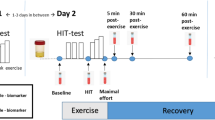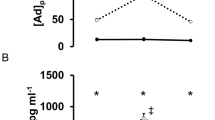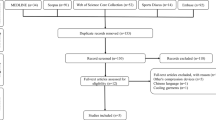Abstract
Design:
Non-randomized study.
Objective:
To determine natural killer cell cytotoxic activity (NKCA) to 2-h arm ergometer exercise in persons with spinal cord injuries (SCI) and the underlying mechanism of such response.
Setting:
University of Occupational and Environmental Health, Japan.
Methods:
We examined NKCA response to 2-h arm crank ergometer exercise at 60% of maximum oxygen consumption (VO2max) in SCI and able-bodied persons. NKCA and plasma concentrations of prostaglandin E2 (PGE2), adrenaline and cortisol were measured before, during and immediately after the exercise. The study included seven subjects with SCI between Th11 and L4 and six able-bodied persons.
Results:
NKCA in able-bodied subjects increased (P<0.05) at 60 min of exercise and immediately after the exercise, and remained elevated up to 2 h after exercise. However, NKCA in SCI decreased (P<0.05) immediately after exercise but recovered at 2 h after exercise. Plasma adrenaline in both groups increased significantly (P<0.05) immediately after exercise and returned to baseline level 2 h after the exercise. Plasma cortisol in both groups remained constant throughout the study. In SCI, PGE2 significantly increased immediately after 2 h exercise and returned to the baseline level 2 h after exercise; however, it remained unchanged during the test in able-bodied subjects.
Conclusion:
Our results suggested that increase of PGE2 in SCI partially contributes to NKCA.
Similar content being viewed by others
Log in or create a free account to read this content
Gain free access to this article, as well as selected content from this journal and more on nature.com
or
References
Jonsdottir IH . Exercise immunology: neuroendocrine regulation of NK-cells. Int J Sports Med 2000; 21 (Suppl 1): S20–S23.
Nieman DC, Nehlsen-Cannarella SL . The immune response to exercise. Semin Hematol 1994; 31: 166–179.
Pedersen BK, Ullum H . NK cell response to physical activity: possible mechanisms of action. Med Sci Sports Exerc 1994; 26: 140–146.
Tvede N, Kappel M, Halkjaer-Kristensen J, Galbo H, Pedersen BK . The effect of light, moderate and severe bicycle exercise on lymphocyte subsets, natural and lymphokine activated killer cells, lymphocyte proliferative response and interleukin 2 production. Int J Sports Med 1993; 14: 275–282.
Bhatt K, Cid E, Maiman D . Bacteremia in the spinal cord injury population. J Am Paraplegia Soc 1987; 10: 11–14.
Kappel M, Tvede N, Galbo H, Haahr PM, Kjaer M, Linstow M et al. Evidence that the effect of physical exercise on NK cell activity is mediated by epinephrine. J Appl Physiol 1991; 70: 2530–2534.
Furusawa K, Tajima F, Tanaka Y, Ide M, Ogata H . Short-term attenuation of natural killer cell cytotoxic activity in paraplegic athletes during wheelchair marathon. Arch Phys Med Rehabil 1998; 79: 1116–1121.
Furusawa K, Tajima F, Umezu Y, Ueta M, Ide M, Mizushima T et al. Activation of natural killer cell function in recreational athletes with paraplegia during wheelchair half marathon race. Arch Phys Med Rehabil 2003; 84: 706–711.
Pedersen BK, Kappel M, Klokker M, Nielsen HB, Secher NH . The immune system during exposure to extreme physiologic conditions. Int J Sports Med 1994; 15: S116–S121.
Shinkai S, Watanabe S, Asai H, Shek PN . Cortisol response to exercise and post-exercise suppression of blood lymphocyte subset counts. Int J Sports Med 1996; 17: 597–603.
Tvede N, Kappel M, Klarlund K, Duhn S, Halkjaer-Kristensen J, Kjaer M et al. Evidence that the effect of bicycle exercise on blood mononuclear cell proliferative responses and subsets is mediated by epinephrine. Int J Sports Med 1994; 15: 100–104.
Pedersen BK, Steensberg A, Fischer C, Keller C, Ostrowski K, Schjerling P . Exercise and cytokines with particular focus on muscle-derived IL-6. Exer Immunol Rev 2001; 7: 18–31.
Suzuki K, Nakaji S, Yamada M, Totsuka M, Sato K, Sugawara K . Systemic inflammatory response to exhaustive exercise. Cytokine kinetics. Exer Immunol Rev 2002; 8: 6–48.
Hunter LW, Rorie DK, Yaksh TL, Tyce GM . Concurrent separation of catecholamines, dihydroxyphenylglycol, vasoactive intestinal peptide, and neuropeptide Y in superfusate and tissue extract. Anal Biochem 1988; 173: 340–352.
Pedersen BK, Tvede N, Klarlund K, Christensen LD, Hansen FR, Galbo H et al. Indomethacin in vitro and in vivo abolishes post-exercise suppression of natural killer cell activity in peripheral blood. Int J Sports Med 1990; 11: 127–131.
Kappel M, Tvede N, Galbo H, Haahr PM, Kjaer M, Linstow M et al. Evidence that the effect of physical exercise on NK cell activity is mediated by epinephrine. J Appl Physiol 1991; 70: 2530–2534.
Nieman DC, Henson DA, Johnson R, Lebeck L, Davis JM, Nehlsen-Cannarella SL . Effects of brief, heavy exertion on circulating lymphocyte subpopulations and proliferative response. Med Sci Sports Exerc 1992; 24: 1339–1345.
Nieman DC . Exercise immunology: practical applications. Int J Sports Med 1997; 18: S91–S100.
Pedersen BK, Tvede N, Christensen LD, Klarlund K, Kragbzk S, Halkjzr-Kristensen J . Natural killer cell activity in peripheral blood of highly trained and untrained persons. Int J Sports Med 1989; 10: 129–131.
Moyna NM, Acker GR, Weber KM, Fulton JR, Robertson RJ, Goss FL et al. Exercise-induced alterations in natural killer cell number and function. Eur J Appl Physiol 1996; 74: 227–233.
Kliesch WF, Cruse JM, Lewis RE, Bishop GR, Brackin B, Lampton JA . Restoration of depressed immune function in spinal cord injury patients receiving rehabilitation therapy. Paraplegia 1996; 34: 82–90.
Schmid A, Huonker M, Barturen JM, Stahl F, Schmidt-Trucksass A, Konig D et al. Catecholamines, heart rate, and oxygen uptake during exercise in persons with spinal cord injury. J Appl Physiol 1998; 85: 635–641.
Nieman DC, Brendle D, Henson DA, Suttles J, Cook VD, Warren BJ et al. Immune function in athletes versus nonathletes. Int J Sports Med 1995; 16: 329–333.
Komaki G, Kanazawa F, Sogawa H, Mine K, Tamai H, Okamura S et al. Alterations in lymphocyte subsets and pituitary-adrenal gland-related hormones during fasting. Am J Clin Nutr 1997; 66: 147–152.
Acknowledgements
We thank Drs Yoshiya Tanaka and Tetsuya Okazaki for their clinical assistance. We are also grateful to Dr Hiroyuki Okawa, Dr Hiroshi Takahashi and Dr Yuichi Umezu for their great contribution in this project. We also thank Dr Faiq G Issa, from Word-Medex Pty Ltd, Sydney, Australia (www.word-medex.com.au), for the careful reading and editing of the manuscript. We acknowledge the skilful assistance of Ms Satoko Aoki, Aya Katayama, Kazumi Ogura, Mr Koichi Monji and Sadanori Takeda. This project was supported in part by the Japanese National Foundation for Scientific Research.
Author information
Authors and Affiliations
Corresponding author
Rights and permissions
About this article
Cite this article
Ueta, M., Furusawa, K., Takahashi, M. et al. Attenuation of natural killer cell activity during 2-h exercise in individuals with spinal cord injuries. Spinal Cord 46, 26–32 (2008). https://doi.org/10.1038/sj.sc.3102054
Received:
Revised:
Accepted:
Published:
Issue date:
DOI: https://doi.org/10.1038/sj.sc.3102054
Keywords
This article is cited by
-
Does 20-min arm crank ergometer exercise increase plasma interleukin-6 in individuals with cervical spinal cord injury?
European Journal of Applied Physiology (2012)
-
Renal function and endocrine responses to arm exercise in euhydrated individuals with spinal cord injury
European Journal of Applied Physiology (2012)
-
Plasma IL-6 levels during arm exercise in persons with spinal cord injury
Spinal Cord (2011)
-
Impaired immune response to voluntary arm-crank ergometer exercise in patients with cervical spinal cord injury
Spinal Cord (2010)
-
Editorial Note on: Impaired immune response to voluntary arm crank ergometer exercise in patients with spinal cord injury
Spinal Cord (2010)



